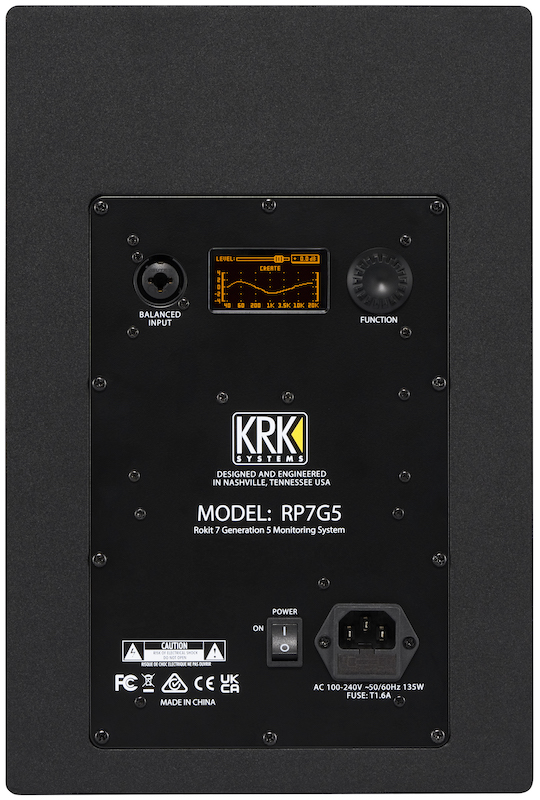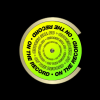-
 play_arrow
play_arrow
Clubalicious Clubalicious Radio
-
 play_arrow
play_arrow
London Calling Podcast Yana Bolder

| MIX VERDICT: KRK ROKIT 7 GENERATION FIVE STUDIO MONITORS |
| THE TAKEAWAY: “These new KRK ROKIT 7 Generation Fives are the best version yet of these already popular monitors.” |
| COMPANY: KRK • www.krkmusic.com PRICE: $269 per speaker. PROS: • The Mix, Create and Focus voicing modes are very useful. CONS: • An update including a Bluetooth app that mirrors LCD Functions would be welcome. |
The new KRK ROKIT Generation Five Studio Monitors— the latest in the brand’s flagship speaker line—come in three sizes, with five, seven and eight-inch woofers. The woofers use woven Kevlar aramid fiber cones and proper ferrite magnets. The high frequencies for all three models are handled by one-inch dome tweeters. All three models use a bass reflex design with a smooth-walled tuned port that extends the width of the front of the cabinet. These two-way studio monitors are bi-amped, powered by Class-D amplifiers.
The ROKIT Generation Five monitors ship with a stylish protective grille. An additional non-protective grille is included if you prefer the drivers exposed. I liked them as they came, with the grilles installed, and there is no acoustical difference between the two styles. The monitors rest on a sound-dampened material glued underneath the base to lessen the transfer of the cabinet’s vibrational energy to whatever surface they are placed on. They also come with foam isolation pads for further sound isolation.

The rear panel includes Friction-Lock Neutrik combo XLR/ TRS input connectors for +4 dB balanced operation. For -10 dBV operation, the manual recommends using an unbalanced adapter cable. For the 30-hour break-in period, I used an RCA-to-1/4-inch TS adapter plug to connect to my TV’s L/R high-impedance, unbalanced outputs and they worked fine. I did have to lift the ground pin on both the AC power cables.
The primary differences, other than their actual physical sizes—13.35 x 8.86 x 11.42 inches, H x W x D, for the ROKIT 7 tested here—are the size of the woofer and the power output from the two amplifiers. The maximum SPL is listed as 108 dB for the ROKIT 5, 110 dB for the ROKIT 7 and 111 dB for the ROKIT 8. The signal-to-noise ratio varies slightly between models, as does the crossover frequency. The ROKIT 7 weighs 16.87 pounds.
Frequency response (+/-3 dB) is 45 Hz to 36 kHz for the ROKIT 7, 42 Hz to 36 kHz for the ROKIT 8, and 54 Hz to 30 kHz for the ROKIT 5. The ROKIT 7 and ROKIT 8 have identical crossover frequencies of 1.64 kHz.
An important specification not often mentioned in monitor specs is coverage angles, which the ROKIT 7 captures at 155 degrees horizontally and 133 degrees vertically. In my control room, musicians rarely sit down between takes. So, with good vertical/horizontal dispersion, I know they are hearing how bright (or not) my mixes or recordings are when standing behind the listening position.
LCD FUNCTION SCREEN, SETUP
The monitors have an amber-colored LCD Function screen in the center of the rear panel, just above the four M6 mounting points. This uses the familiar cursor/data entry scheme with a single knob to scroll through menus, followed by a “push” of the knob to select a highlighted choice or to dive into a submenu section for more.
When the monitor is first powered up, the LCD screen shows a fader to adjust the operating level in 0.1 dB steps, based on a +4 dBu, factory-set input sensitivity. In this way, you may adjust the monitor’s level to match other monitors in your room, solving a common issue when switching between monitors while playing music. The LCD screen also shows the currently running Voicing Mode, its frequency curve and any EQ changes already stored.
For instant access from the startup page, pushing the function knob will get you to the home page, where you find three window options: EQ, Setup and Back. Scroll and push the knob once to enter any of these sub-section windows. The EQ function, one of the newest features added to this generation, is used to select between three Voicing Modes: Mix, Create and Focus. All three Voicing Modes can also have an EQ preference applied on top of their built-in curves, with that same EQ held until changed on the other two modes. All three monitors in the line have the same set of Voicing Modes, with each optimized specifically to the model.
Mix mode has a flat frequency and phase response for mixing, mastering and critical listening. Create mode is suggested for writing, producing and casual listening. It has a pleasant-sounding “smiley curve,” with a lowered midrange and slightly boosted top and bottom.
Harrison 32Cpre+, MR3eq and Comp 500 Series Units — A Mix Real-World Review
It’s good for listening at a lower volume. By contrast, the Focus mode has a broad (Q) boost at 1 kHz for hearing vocal lyrics and other critical midrange elements in your mix. I liked this to “dig out” obscured lead vocals so that I could hear lyrics clearly. The high frequencies are adjustable in +/-2 dB steps for high-shelving at 10 kHz and +/-1 dB for a peaking EQ at either 10 kHz, 3.5 kHz or flat. More difficult rooms with low-frequency modal problems might require more EQ points.
The KRK ROKIT 7s have two EQ positions in the bass: +/-2 dB at 60 Hz using a shelving EQ and -2 dB at 200 Hz for a peaking EQ. Low EQ also has a position that provides -2 dB cut at both 60 Hz and 200 Hz for more correction when the monitor is placed too close to walls, where Surface-Boundary Interference Reflections can create problems.
The Setup page is for setting up overall system preferences. You’ll have to scroll around the menu to find what you want to change from factory settings. Selecting a parameter makes it adjustable with the knob.
Parameters are available for the brightness and contrast of the backlit display, whether the KRK logo is on, off, or dimmed, a factory reset for all parameters (if you get lost), and a power-save feature where the monitor goes to sleep when there is no audio input for 30 minutes.
Once you have a setup “dialed in,” you can lock it down so no further adjustments can be made until you purposely unlock them. If the LCD is not lit, pushing on the knob awakens it.
STUDIO SETUP AND MIXING
The KRK ROKIT 7s were perfect for my small mix room which is just 9.5 feet wide with an 8-foot ceiling. I removed my previous studio monitors and placed the KRKs on my Sound Anchor stands, angled inward, and set them at the recommended height (where my eyes are looking at the space between the woofer and tweeter).
I had them at 36 inches above my reflective hardwood floor, 36 inches from both the left and right walls, and 36 inches apart to obey the rule of the “magic triangle.” The listening position is out front at the third corner of an equilateral triangle, where the front left and right corners dictate the location of the L/R monitors.
With the default factory settings, my initial impression was that the speakers were lacking a little bass (at least in my studio), so I switched to the flat Mix mode and dove into the EQ page.
I scrolled to Low EQ and added a +2 dB shelf at 60 Hz. This worked well to keep my mixes from being bass heavy. If you are working in immersive music formats or 5.1/7.1 mixing and require an LFE channel, or are mixing in a larger room, or simply like more subsonic level, KRK recommends the S8.4 Powered Subwoofer. I was happy with the bass sound.
Once set up in my mix room, the ROKIT 7s performed well for mid-volume-level mixing. They have good, clear stereo imaging, and I sometimes used the -2 dB at 10 kHz shelf if they seemed a little bright when playing back mastered, bright pop songs. It is nice to have this option, and I wish the DSP functionality had a Bluetooth app for my phone—then I could sit at the listening position to hear the EQ changes.
While I had the ROKIT Generation Five monitors set up in my studio, I had to mix a new artist who wanted to sit in to see my process. They were amazed that their music could sound so balanced when mixed on these monitors. A rough mix passed the car test well. Not too booming in the bass, the low-midrange was balanced, and the stereo effects—reverb and delays—sat well. These new KRK ROKIT 7 Generation Fives are the best version yet of these already popular monitors.
Written by: Admin
Similar posts
Recent Comments
No comments to show.Featured post

Latest posts
Current show

On The Record
Insomniac Events
On The Record is a weekly radio show featuring an endless rotation of the most noteworthy artists from around the world.
closeUpcoming shows

Femme House
Lp giobbi
00:00 - 01:00
On The Record
Insomniac Events
01:00 - 02:00
Fresh Is Fresh
This Weeks Hottest Releases
02:00 - 09:00
Love To Be
The Global Connection
09:00 - 11:00
Fresh Is Fresh
This Weeks Hottest Releases
11:00 - 15:00Chart
Powered by Dee jay promotions visit us












 Invalid license, for more info click here
Invalid license, for more info click here